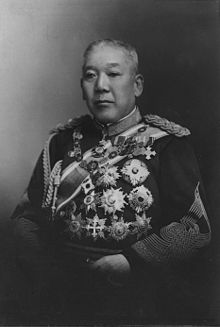Ōyama Iwao
Ōyama Iwao | |
|---|---|
 | |
| Allegiance | Empire of Japan |
| Service/ | |
| Years of service | 1871 - 1914 |
| Rank | Field Marshal |
| Battles/wars | Boshin War Satsuma Rebellion First Sino-Japanese War Russo-Japanese War |
| Awards | Order of Merit Order of the Golden Kite (1st class) Order of the Chrysanthemum |
| Other work | Lord Keeper of the Privy Seal |
Template:Japanese name Prince Ōyama Iwao, OM (大山 巌, 10 October 1842 - 10 December 1916) was a Japanese field marshal, and one of the founders of the Imperial Japanese Army.
The community of Oyama, British Columbia, Canada is named after Prince Ōyama Iwao.[1]
Biography
Early life
Ōyama was born in Kagoshima to a samurai family of the Satsuma han domain. A protégé of Ōkubo Toshimichi, he worked to overthrow the Tokugawa Shogunate and thus played a major role in the Meiji Restoration. He served as commander in chief of the Detached First Brigade during the Boshin War. At the Battle of Aizu, Ōyama was a commander at the Satcho Alliance's field artillery positions on Mount Oda. During the course of the siege, he was wounded by an Aizu guerilla force under Sagawa Kanbei.
Kimigayo
In 1869, the British military band instructor John William Fenton, who was then working in Yokohama as a o-yatoi gaikokujin, told the members of Japan's military band about the British national anthem "God Save the King" and emphasized the necessity of a similar national anthem for Japan. The band members requested artillery Captain Ōyama Iwao, who was well versed in Japanese and Chinese literature, to select appropriate words and Ōyama selected the poem which came to be used in Japan's national anthem kimigayo.

Military career
In 1870, Ōyama was sent overseas to the École Spéciale Militaire de Saint-Cyr in France to study and he was official Japanese military observer to the Franco-Prussian War. He also spent three years (1870-1873) in Geneva studying foreign languages, and became fluent in Russian. Ōyama Iwao is the first recorded Japanese customer for Louis Vuitton, having purchased some luggage during his stay in France. After promotion to major general, he went to France again for further study, together with Kawakami Sōroku. [2]On his return home, he helped establish the fledgling Imperial Japanese Army, which was soon employed in suppressing the Satsuma Rebellion, although Ōyama and his elder brother were cousins of Saigō Takamori.
In the First Sino-Japanese War, Ōyama was appointed Commander-in-Chief of the Japanese Second Army, which after landing on Liaotung Peninsula, carried Port Arthur by storm, and subsequently crossed to Shantung, where it captured the fortress of Weihaiwei.
For these services Ōyama received the title of marquis under the kazoku peerage system, and, three years later, he became field-marshal. In the Russo-Japanese War of 1904-1905 he was named commander-in-chief of the Japanese armies in Manchuria. After Japan's victory, Emperor Meiji elevated him to the rank of kōshaku (公爵 = prince). [3]

Political career
As War Minister in several cabinets and as Chief of Staff, Ōyama upheld the autocratic power of the oligarchs (genrō) against democratic encroachments. However, unlike Yamagata Aritomo, Ōyama was reserved and tended to shun politics. From 1914 he served as Lord Keeper of the Privy Seal.
Personal life

Ōyama, who spoke and wrote several European languages fluently, also liked European-style architecture. During his tenure as War Minister, he built a house in Tokyo modeled after a German castle.
Although he was very pleased with the design, his wife did not like it at all, and insisted that the children's room be remodeled in Japanese style, so that they would not forget their Japanese heritage. [4]The house was destroyed by American air raids in World War II. Ōyama's wife Yamakawa Sutematsu (sister of former Aizu retainers Yamakawa Hiroshi and Yamakawa Kenjiro) was one of the first female students sent to the United States by the Empress of Japan in the early 1870s. She spent several years there, graduating from Vassar College in 1882.[5]
In 1906, Ōyama was awarded the Order of Merit by King Edward VII. His Japanese decorations included Order of the Golden Kite (1st class) and Order of the Chrysanthemum.
Ōyama died at age 75 in 1916. Ōyama was a very large man, and enjoyed large meals. His weight exceeded 95 kilograms, and his death is now attributed to complications arising from diabetes.
Notes
References
- Bix, Herbert B. (2001). Hirohito and the Making of Modern Japan. Harper Perennial. ISBN 0-06-093130-2.
- Dupuy, Trevor N. (1992). Encyclopedia of Military Biography. I B Tauris & Co Ltd. ISBN 1-85043-569-3.
- Jansen, Marius B. (1986). Japan in Transition: From Tokugawa to Meiji. Princeton University Press. ISBN 1-85043-569-3.
- Jansen, Marius B. (2000). The Making of Modern Japan. Balknap Press. ISBN 0-674-00991-6.
- Keane, Donald (2005). Emperor Of Japan: Meiji And His World, 1852-1912. Columbia University Press. ISBN 0-231-12341-8.
External links
- National Diet Library. "Oyama Iwao". Portraits of Modern Historical Figures.
- Adachi, Kinnosuke (1905-07-23). "The Wife of Japan's Great General Oyama". New York Times. Retrieved 2010-05-20.
- VancouverIsland.com. "Oyama, Lake Country, Okanagan Valley, BC".
- Marshals of Japan
- Meiji Restoration
- People from Satsuma Domain
- Ministers of Army of Japan
- 1842 births
- 1916 deaths
- Kazoku
- People of the Boshin War
- People of the First Sino-Japanese War
- People of the Russo-Japanese War
- People in Meiji period Japan
- People from Kagoshima Prefecture
- Shimazu retainers
- Honorary Members of the Order of Merit
- Recipients of the Order of the Golden Kite
- Recipients of the Order of the Rising Sun
- Recipients of the Order of the Black Eagle
- Saint-Cyrians
- Légion d'honneur recipients
